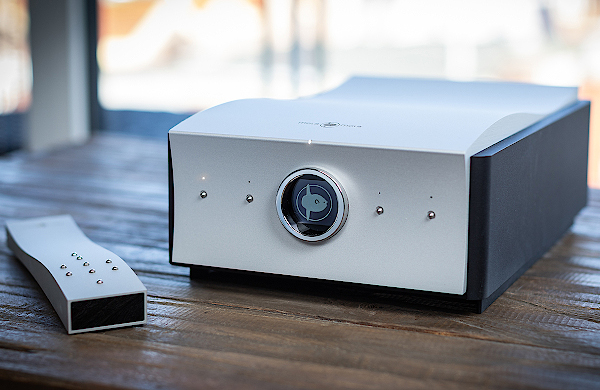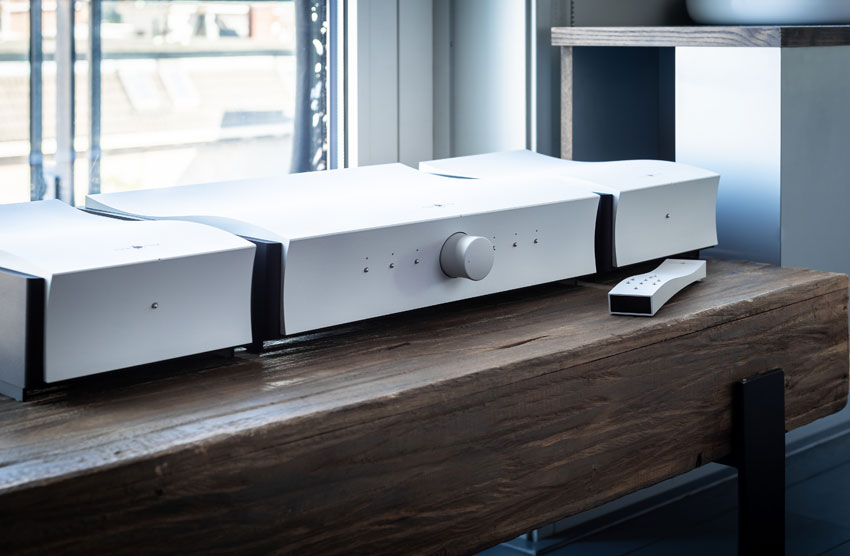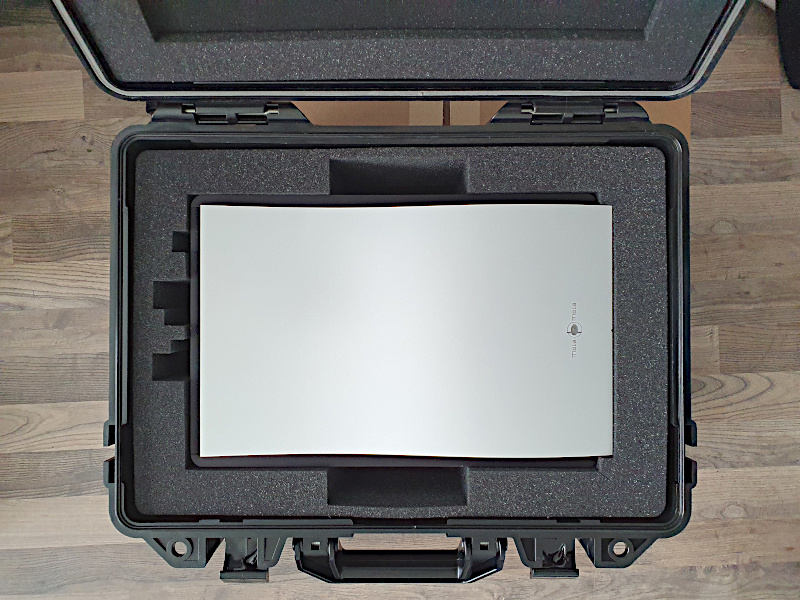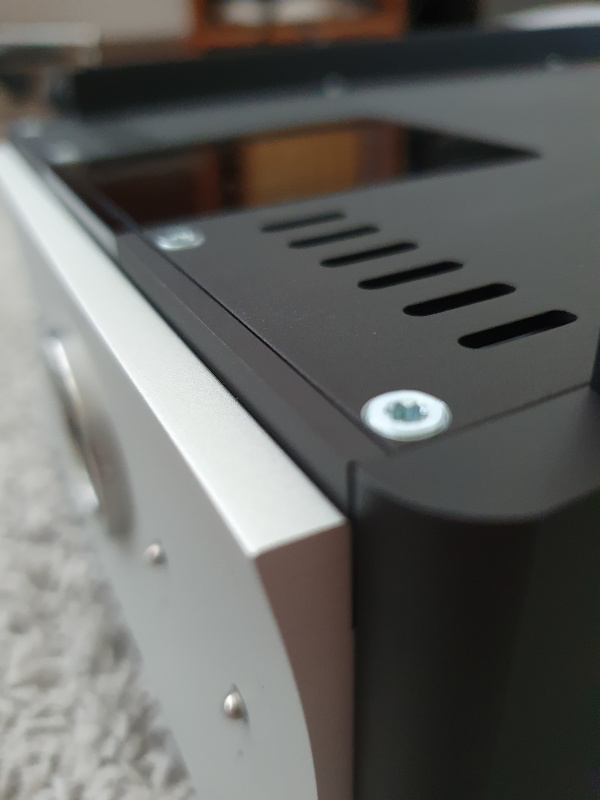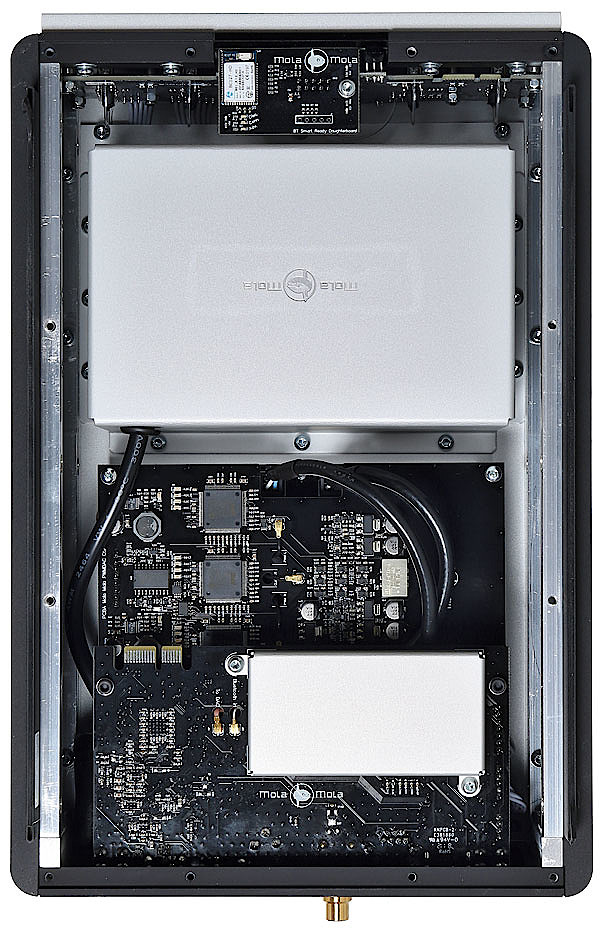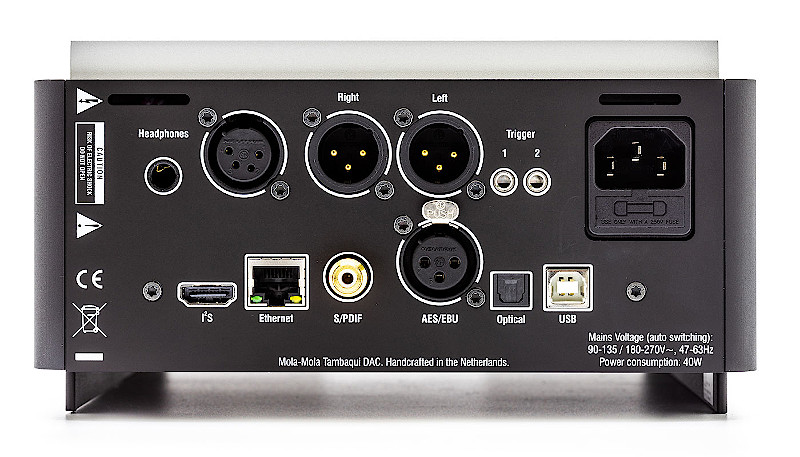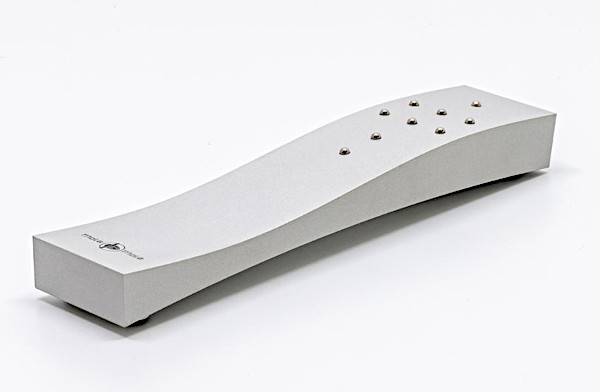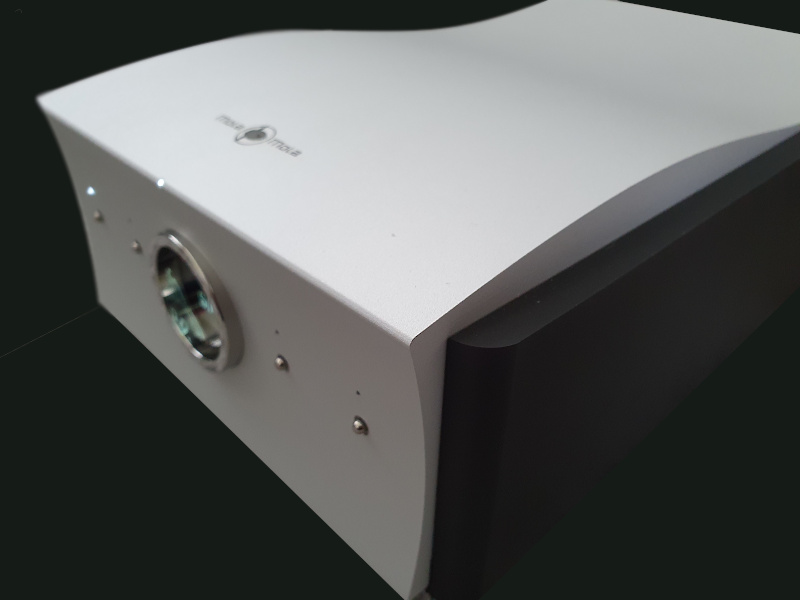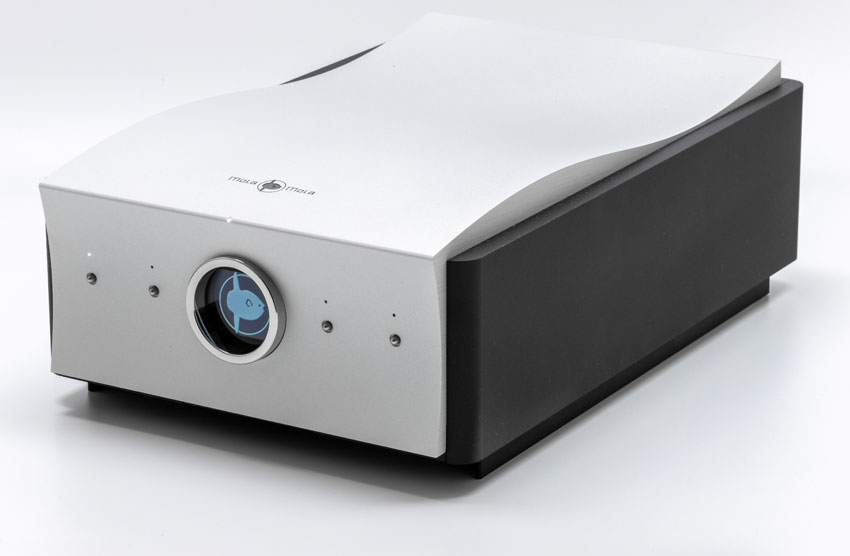MOLA MOLA Tambaqui
Digital sources
Digital that’s as good as analogue, says the Mola Mola website. After my time with the Tambaqui is over and I can reflect on what I’ve heard, I would perhaps correct this sentence slightly to “Digital that is better than analogue”. Until now, no other digital component had crossed this border.
Funkce a forma
Don´t forget to mention the packaging and the feet! This was the first note scribbled down on paper about the Tambaqui. I spent over a week with this DAC and during this period the notes swelled up to a small novel so it was quite easy to extract this text from them. So let me start with the packaging and the feet.
I love reviewing the stuff like this Mola Mola: it is lightweight, compact, and delivered in a neat plastic case lined with thick and dense foam. Unlike other high end electronics the Tambaqui does not require several people for unpacking and transport, and you don´t need a garden shed to dispose the packaging. And what about the feet? There are none. The Tambaqui has two metal profiles running along its depth on which it rests. I see it as no issue, audiophiles tend to place the equipment on aftermarket feet anyway and even if not, the metal profiles provide the same service as any feet.
Well, enough on the packaging and feet, let´s take a closer look at the device.
The DAC can be controlled in three ways. First, there are four microbuttons on its curved faceplate with which the basic functions can be accessed. Second, one can use the provided remote controller (a standard Apple wand) or buy Mola Mola´s own remote for extra. The second solution is more stylish yet rather expensive. Third – and the most elegant and convenient solution – is to install a Mola Mola App on your smartphone which is what I did. Pairing the app with the DAC was a matter of seconds and the rest was super-intuitive. In fact, from the moment the app was downloaded till it was up and running less than 2 seconds passed (on Samsung phone). I did not have to wait watching pairing LED blinking or desperately search for devices to see each other and setting all the parameters of the Tambaqui was a breeze. I used the phone as a volume control (which Mola Mola claims is lossless) afterwards.
The Tambaqui shares its topology with the DAC that Mola Mola uses inside the Makua preamplifier. It means that the converter is a two board stack. On the first board, all incoming digital audio is upsampled to 3.125MHz/32 bits and converted to noise shaped PWM. On the other board are two mono DACs, in which the PWM is converted into analogue. The DAC claims amazing 130dB signal-to-noise ratio, which is near the theoretical limit for 24-bit files and far beyond that of even quad-speed DSD, and excellent jitter values (<1ps from 10Hz). It is of interest that the Tambaqui leads the chart of all DACs measured by The Audio Science Review server.
The Tambaqui weighs only 5kg and its curvy aluminum chassis is not stackable. The digital inputs include Toslink optical, coaxial RCA S/PDIF, AES/EBU, USB-B, Ethernet RJ-45, all Bluetooth protocols and I2S HDMI. The output is only available on balanced XLR connectors and I wished there had been also an RCA analogue output. Fortunately there is a headphone output, either on 4-pin XLR or on 6.3mm jack.
Nízké frekvence
I used the Tambaqui in its purest form and connected it between the Accuphase digital transport and my power amplifier, thus the built-in digital volume control was activated. I used the S/PDIF connection and the excellent Krautwire Numeric digital interconnect. The first album I cued up was the 16/44.1 Where Corpses Sink Forever of Carach Angren. This richly arranged and heavy music has stellar production, intertwining acoustic and electric instruments, and a symphony orchestra in it. And it is Dutch, like the Mola Mola.
First I wanted to make sure that the digital volume control is not really detrimental to the sound and it was not. No matter how much attenuated the sound remained crisp, perfectly balanced and highly dynamic. This mostly characterizes the performance of the Tambaqui as a whole. The bass and the kick drum were massive through the Mola Mola. They were heavier, punchier and more articulated than through my reference DAC. The music became monolithically crushing and uber-resolved at the same time, as if I combined studio monitors with a pair of impeccably matched subwoofers. The extra weight in lows contributed to a better sense of scale so the symphonic orchestra in the Where Corpses Sink Forever not only did provide myriads of details but it also sounded grandiose and tubas acquired almost apocalyptic dimensions. That’s not a bad start.
Čistota rozlišení
The superiority of the Mola Mola Tambaqui’s bass (and I mean its superiority over any other DAC or digital player I ever had in my room) was unquestionable. The bass line with which Ain´t No Sunshine (Smoma, Roof Music) starts was deep, accurate and dynamically clean. When PW reviewed Mola Mola Kaluga monoblocks two years ago he was raving about how taut and full-fledged the bass was. It looks that in Mola Mola they have the recipe how to make the bass resolved, round and full at the same time, down to the lowest octaves. The Tambaqui sounded physiologically urgent, ever so slightly warm, and extremely controlled. A true high-end elite.
Tonální věrnost
The midrange is a domain of human voices so I used a multi-voice recording to listen whether the all digital Tambaqui could convey the sense of real people in real spaces. The Persuasions (Chesky/In-Akustik) is an a-capella ensemble and the guys materialized in my listening room with fantastic presence. The presence that had not only high spatial acuity but also was as natural in timbre as with any great analog electronics. The articulation was top notch, with the voices anchored in chests rather than mouths, no etch or overdrawn sibilants, everything clean as a spring day. The midrange of the Mola Mola was not forward like with the Rockna Wavelight DAC (that I had in my system during summer) but it was not reticent either. The excellent bottom end, which the Rockna was missing, counterbalanced it really nicely so the Tambaqui sounded unforced and sumptuous at the same time.
The slightly forgiving rendering of the Tambaqui helped lesser recordings to shine, like Brook & Dunn’s Hillbilly Deluxe (Sony) country album. Actually, I would not expect sonically inferior tracks from The Mastering Lab and Doug Sax and Robert Hadley behind mastering consoles, but here you are. The sound is rather thin and sparkling way too much and the vocals are flat and compressed, so the sound is not cohesive yet the music is nice and at places beautifully arranged. The Mola Mola did not smooth it out and actually shed even more light onto mixing errors, but it did so in an elegant way and the tracks were listenable and enjoyable as a result.
Prostorovost
And the soundstage! Yes, the Tambaqui’s soundstage was the most exact I’d ever heard from any piece of electronics. The ambient cues in Rutter’s Requiem (Hyperion Records, Polyphony Bournemouth Sinfonietta) drew the map of the recording venue before the music actually started. Then the first few bars came and the soundstage was wide and deep and high, with all performers placed within it with no ambiguity. The Tambaqui did not have the “black” background, quite contrary it was populated with subtle sounds of the ambience that made the experience so real. In fact, there is nothing like black background in real life outside anechoic chambers and the devices that are claimed to have it usually fail in showing the faintest of the reverbs. Maybe that was why the Tambaqui excelled so much in drawing my attention to the musical events that happened in the very depth of the orchestra and that became so wonderfully articulated through it.
In the course of the days with the Mola Mola Tambaqui I only found one thing that was a nuisance and that had nothing to do with how the DAC sounded: the app could dim the display or switch it off completely, yet the status LEDs on fascia kept shining bright. It could have been covered with a piece of paper, problem solved. Other than that the Mola Mola Tambaqui is the best DAC that money can buy today.
P.S. The Tambaqui is a half-width component and its surface is rather small. The aluminum sheets of the chassis got quite hot after several hours of listening. Don’t forget to place the DAC at a well ventilated place.
Připojené komponenty
- Sources: Accuphase DP-720, Mark Levinson No.519
- Amplifiers: TAD M-2500, Leak Stereo 130
- Interconnects and speaker cables: AudioQuest Dragon Bass | Zero, Krautwire Numeric Digital, Krautwire MAX-S, Ansuz Signalz C2, Ansuz Signalz D2, Accuphase RCA, AudioQuest Carbon
- Loudspeakers: TAD Evolution One E1, Sonus Faber Gravis I
- Power conditioning: Block Audio Snakeblock, Shunyata Research Denali, Synergistic Research Atmosphere Level 2, Nordost Qv2, Qk1 and QPoint, Stromtank S-1000 a S-2500 Quantum
ACCUPHASE DG-58
The Accuphase DG-58 is a 4th generation 'voicing equalizer' of Japanese manufacturer. The device won me over with its impeccable finish, top notch operation and a friendly user interface. It comes in traditional satin gold with high ...
Doporučení prodejci
Nisel SK, Bratislava, tel. +421 905 203 078
ACCUPHASE DP-720 SACD
Accuphase engineers further expanded on the features that had made their DP-900/DC-900 transport/DAC combo so phenomenal - the result is the one-box DP-720. This player is built with almost fanatical attention to detail. The ...
Doporučení prodejci
Nisel SK, Bratislava, tel. +421 905 203 078
ACCUPHASE DP-770 SACD
Every new product from this Japanese manufacturer is a small feast, especially if it is a device positioned at the top of the product line. Also, although affordability may be a relative term, spending under 20,000 euro for a digital ...
Doporučení prodejci
Perfect Sound Group, Praha, tel. +420 722 960 690
Nisel SK, Bratislava, tel. +421 905 203 078
ARIES CERAT Kassandra II Reference DAC
After spending time with the Aries Cerat device I believe I better understand why there is so much enthusiasm about the brand in hifi circles. The Kassandra DAC, if set up properly, provides pure and strong sound that combines ...
Doporučení prodejci
Mecca Highend s.r.o., Vraclav, +420 732 576 216
AUDIOLAB 8300CD
The 8300CD is a preamplifier, a CD player and a DAC (ESS Sabre), all in one neat package. Audiolab offers 8300MB monoblocks that are half-width of the 8300CD so the two monos and one source component create a compact high end system. ...
Doporučení prodejci
Horn Distribution, Praha, +420 272 656 485
AUDIOQUEST Dragonfly Red
The original USB DAC of Audioquest happened to be a small revolution back in 2012. Four years later there are already more newborn dragonflies – v1.2, Black and Red. This review is focusing on the latest Red version that has ...
Doporučení prodejci
AQ s.r.o., Červenka, tel. +420 585 342 232
AYON CD-07s
Smooth liquidity is another typical element of the Ayon sound. The sound is analog-like, viscose, fluid, flowing, smooth. You may as well discard all these adjectives and replace them with the single formulation: the Ayon is a ...
Doporučení prodejci
Nisel SK, Bratislava, tel. +421 905 203 078
